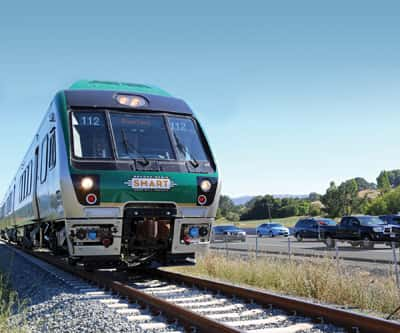SMART Releases Emissions Information
 Sonoma-Marin Area Rail Transit released a “Green Commute” fact sheet earlier this year, ahead of a March vote on its future with a proposed 30-year tax extension, dubbed Measure I.
Sonoma-Marin Area Rail Transit released a “Green Commute” fact sheet earlier this year, ahead of a March vote on its future with a proposed 30-year tax extension, dubbed Measure I.
According to SMART, swapping a car commute for a ride to work on the train reduced greenhouse gas emissions by 33 percent. Furthermore, the majority of riders, 64 percent, get to and from the train using green transportation, including walking, bicycling or other types of public transit.
Regarding SMART’s clean-diesel engines, the organization says they meet the Environmental Protection Agency’s Tier 4 emissions standards, cutting particulate matter emissions by 96 percent and nitrogen emissions by 93 percent, compared to conventional diesel engines.
As of now, SMART’s average weekday ridership is 2,600 passengers. If those commuters drove, it’s estimated that 2,407 additional cars would be on the roads of the North Bay each day. Additionally, with roughly 1.72 million SMART rides taken thus far, the train has prevented 8.1 million pounds of CO2 from polluting the environment. “SMART is undeniably a critical transportation option that results in far fewer greenhouse gas emissions than a single occupancy car,” says Suzanne Smith, executive director of the Sonoma County Transportation Authority and the Regional Climate Protection Authority, in a prepared statement. “We need SMART. We need all of the tools available to reduce emissions.”
A Waste of Time
In a report from the Texas A&M Transportation Institute, researchers determined the average American commuter wastes 54 extra hours a year in traffic delays. By “extra hours” they mean the extra time spent traveling at congested speeds rather than free-flow speeds. That adds up to two-and-a-half days. That’s an extra weekend.
Commuters in the 15 most-congested cities spent an average of 83 hours stuck in traffic in 2017, the most recent year for which data was available. In Los Angeles, the most congested metro area, stalled traffic robbed commuters of an average of 119 hours that year.
Crowdsourcing
NorthBay biz asked SMART train commuters arriving and leaving the downtown Santa Rosa station their thoughts on the impending Measure I vote and whether the train is beneficial to the community. Here’s what local commuters had to say.
“It’s faster, but it’s also much less stressful for me to get to work. I can check my email, or finish up some paperwork on the way to work or on the way home, instead of taking that home.”
Jessica Ortiz, Santa Rosa
“It actually allows me to bring my bike, so I can bike the rest of the way to work and home.”
Paula Aquino, Santa Rosa
“I don’t have a car, so it helps me commute to campus and it’s an expense I don’t have to worry about. Cars are expensive.”
Cynthia Dunster, Petaluma
“Taking my bike to Novato beats traffic in Petaluma, or the two-lane narrows any day.”
Timothy Rees, Santa Rosa
“Honestly, just trying to find ways to use my car less, the SMART train is relatively close to home and work, so using a car isn’t mandatory anymore for me.”
Al Bell, Santa Rosa




